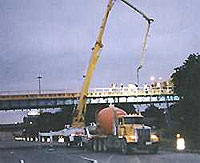The Largest Single Highway Repair Project in Detroit's History December 1999
Putzmeister equipment helps contractor beat deadlines on 38-bridge project
In September, the largest single road repair project in the history of Detroit was completed. The $60 million project involved closing surface streets, on and off ramps and 3.1 miles (5 km) of Interstate 75, a freeway running through downtown Detroit used by 120,000 motorists a day.
In addition to reconstructing portions of the 36-year-old freeway, 38 bridge decks were also replaced or repaired. According to the Michigan Department of Transportation (MDOT), the construction effort will provide "at least 20 years of road use without major rehabilitation."
The Detroit project also took an aggressive, single-season tact, shaving up to three years off parts of the timetable. MDOT also included a sizeable financial incentive and disincentive component to encourage early completion.
"It's the largest project incentive I've seen in 26 years," said Dusty Barclay, project manager for bridge contractor C.A. Hull, describing the project's $65,000-a-day incentive plan. "We finished phase one in 116 days – 12 days ahead of schedule – and completed year 2000 work in September 1999."
Jerry Donnelly, branch manager of concrete pumping contractor Pumpco, Inc., said the I-75 job was the most logistically demanding job he's managed in 20 years of concrete work.
To construct more than two dozen new bridges and repair a dozen others, the job required the use of the company's entire inventory of Putzmeister concrete pumping and conveying equipment. Plus, Donnelly said Pumpco purchased $1 million worth of new equipment for the project.
He explained that they not only had an aggressive schedule for manpower and pumps, but they also had a daily challenge of getting to the site and finding out where and how to deliver the concrete.
MDOT closed the state roads surrounding all the major interchanges under construction from 8 p.m. to 6 a.m. In addition, MDOT required all decks to be poured at night to alleviate water evaporation from the concrete and traffic disruption.
"With this tight schedule, we were constantly verifying site and delivery logistics," said Donnelly. "I'd arrive prior to the road closings and radio directions to the pump and ready-mix crews. The job changed every day." The expedited schedule challenged everyone involved. Barclay said, "It took a lot of coordination to schedule 160 laborers, working in two shifts 24 hours a day, six days a week."
"The largest bridge we worked on was about 800 feet (244 m) long and required 650 cubic yards (497 m3) of concrete." He explained, "Each deck was different. Some were four lanes wide, others were parallel two-lane structures. The project included overpasses, underpasses and single-lane ramps. Some bridges were even over live traffic."
Several different Putzmeister units were used to place 15,000 cubic yards (11,468 m3) of 4,500 psi concrete bridge deck mix, as well as the latex concrete mix used on pier and abutment repairs. The project also required 1,654 tons (1,500 metric tons) of reinforcing steel.
The equipment included 52Z-, 42- and 36-Meter truck-mounted boom pumps, several trailer pumps and a Telebelt® TB 105 conveyor. "The TB 105s can move a whole lot of concrete fast," said Donnelly. "We used them on the two largest pours – 650 and 400 cubic yards (497 and 306 m3)."
The majority of the 5-inch (127 mm) slump concrete, however, was pumped with a 52-Meter pump. "The 52Z has a five-section boom that gave us up to 170 feet (52 m) of reach," said Donnelly. Reach proved critical on many deck pours, but the pump's free-flow hydraulics kept line surge under control. "I only have good things to say about the Putzmeisters, especially the 52-Meter pumps," said bridge veteran Barclay. "They performed well – with a lot less thrusting back and forth."
According to MDOT, Michigan is spending a record $1.2 billion in 1999 for road and bridge repair. The I-75 project, which involved more than 300 construction workers, dovetails with Detroit's downtown renaissance construction effort that includes building two new stadiums and three casinos, in addition to expansions at area automobile plants.
























.jpg)
.gif)

.jpg)








.jpg)








